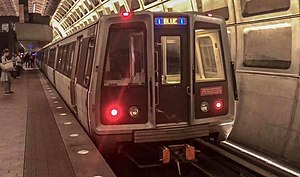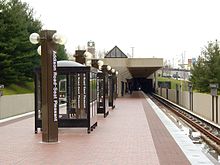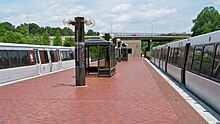華盛頓地鐵藍線
 藍線列車停靠史密森尼站 | |||||||||||||||||||||||||||||||||||||||||||||||||||||||||||||||||||||||||||||||||||||||||||||||||||||||||||||||||||||||||||||||||||||||||||||||||||||||||||||||||||||||||||||||||||||||||||||||||||||||||||||||||||||||||||||||||||||||||||||||||||||||||||||||||||||||||||||||||||||||||||||||||||||||||||||||||||||||||||||||||||||||||||||||||||||||||||||||||||||||||||||||||||||||||||||||||||||||||||||||||||||||||||||||||||||||||||||||||||||||||||||||||||||
| 概覽 | |||||||||||||||||||||||||||||||||||||||||||||||||||||||||||||||||||||||||||||||||||||||||||||||||||||||||||||||||||||||||||||||||||||||||||||||||||||||||||||||||||||||||||||||||||||||||||||||||||||||||||||||||||||||||||||||||||||||||||||||||||||||||||||||||||||||||||||||||||||||||||||||||||||||||||||||||||||||||||||||||||||||||||||||||||||||||||||||||||||||||||||||||||||||||||||||||||||||||||||||||||||||||||||||||||||||||||||||||||||||||||||||||||||
| 營運地點 | 維吉尼亞州(費爾法克斯郡、亞歷山卓市、阿靈頓縣) 華盛頓特區 馬里蘭州(喬治王子縣) | ||||||||||||||||||||||||||||||||||||||||||||||||||||||||||||||||||||||||||||||||||||||||||||||||||||||||||||||||||||||||||||||||||||||||||||||||||||||||||||||||||||||||||||||||||||||||||||||||||||||||||||||||||||||||||||||||||||||||||||||||||||||||||||||||||||||||||||||||||||||||||||||||||||||||||||||||||||||||||||||||||||||||||||||||||||||||||||||||||||||||||||||||||||||||||||||||||||||||||||||||||||||||||||||||||||||||||||||||||||||||||||||||||||
| 服務類型 | 都市軌道運輸系統 | ||||||||||||||||||||||||||||||||||||||||||||||||||||||||||||||||||||||||||||||||||||||||||||||||||||||||||||||||||||||||||||||||||||||||||||||||||||||||||||||||||||||||||||||||||||||||||||||||||||||||||||||||||||||||||||||||||||||||||||||||||||||||||||||||||||||||||||||||||||||||||||||||||||||||||||||||||||||||||||||||||||||||||||||||||||||||||||||||||||||||||||||||||||||||||||||||||||||||||||||||||||||||||||||||||||||||||||||||||||||||||||||||||||
| 所屬系統 | 華盛頓地鐵 | ||||||||||||||||||||||||||||||||||||||||||||||||||||||||||||||||||||||||||||||||||||||||||||||||||||||||||||||||||||||||||||||||||||||||||||||||||||||||||||||||||||||||||||||||||||||||||||||||||||||||||||||||||||||||||||||||||||||||||||||||||||||||||||||||||||||||||||||||||||||||||||||||||||||||||||||||||||||||||||||||||||||||||||||||||||||||||||||||||||||||||||||||||||||||||||||||||||||||||||||||||||||||||||||||||||||||||||||||||||||||||||||||||||
| 目前狀況 | 營運中 | ||||||||||||||||||||||||||||||||||||||||||||||||||||||||||||||||||||||||||||||||||||||||||||||||||||||||||||||||||||||||||||||||||||||||||||||||||||||||||||||||||||||||||||||||||||||||||||||||||||||||||||||||||||||||||||||||||||||||||||||||||||||||||||||||||||||||||||||||||||||||||||||||||||||||||||||||||||||||||||||||||||||||||||||||||||||||||||||||||||||||||||||||||||||||||||||||||||||||||||||||||||||||||||||||||||||||||||||||||||||||||||||||||||
| 起點站 | 法蘭克尼亞–春田 | ||||||||||||||||||||||||||||||||||||||||||||||||||||||||||||||||||||||||||||||||||||||||||||||||||||||||||||||||||||||||||||||||||||||||||||||||||||||||||||||||||||||||||||||||||||||||||||||||||||||||||||||||||||||||||||||||||||||||||||||||||||||||||||||||||||||||||||||||||||||||||||||||||||||||||||||||||||||||||||||||||||||||||||||||||||||||||||||||||||||||||||||||||||||||||||||||||||||||||||||||||||||||||||||||||||||||||||||||||||||||||||||||||||
| 終點站 | 拉戈鎮中心 | ||||||||||||||||||||||||||||||||||||||||||||||||||||||||||||||||||||||||||||||||||||||||||||||||||||||||||||||||||||||||||||||||||||||||||||||||||||||||||||||||||||||||||||||||||||||||||||||||||||||||||||||||||||||||||||||||||||||||||||||||||||||||||||||||||||||||||||||||||||||||||||||||||||||||||||||||||||||||||||||||||||||||||||||||||||||||||||||||||||||||||||||||||||||||||||||||||||||||||||||||||||||||||||||||||||||||||||||||||||||||||||||||||||
| 技術數據 | |||||||||||||||||||||||||||||||||||||||||||||||||||||||||||||||||||||||||||||||||||||||||||||||||||||||||||||||||||||||||||||||||||||||||||||||||||||||||||||||||||||||||||||||||||||||||||||||||||||||||||||||||||||||||||||||||||||||||||||||||||||||||||||||||||||||||||||||||||||||||||||||||||||||||||||||||||||||||||||||||||||||||||||||||||||||||||||||||||||||||||||||||||||||||||||||||||||||||||||||||||||||||||||||||||||||||||||||||||||||||||||||||||||
| 路線結構 | 地面、高架、地下 | ||||||||||||||||||||||||||||||||||||||||||||||||||||||||||||||||||||||||||||||||||||||||||||||||||||||||||||||||||||||||||||||||||||||||||||||||||||||||||||||||||||||||||||||||||||||||||||||||||||||||||||||||||||||||||||||||||||||||||||||||||||||||||||||||||||||||||||||||||||||||||||||||||||||||||||||||||||||||||||||||||||||||||||||||||||||||||||||||||||||||||||||||||||||||||||||||||||||||||||||||||||||||||||||||||||||||||||||||||||||||||||||||||||
| 路線長度 | 30.3英里(48.8公里) | ||||||||||||||||||||||||||||||||||||||||||||||||||||||||||||||||||||||||||||||||||||||||||||||||||||||||||||||||||||||||||||||||||||||||||||||||||||||||||||||||||||||||||||||||||||||||||||||||||||||||||||||||||||||||||||||||||||||||||||||||||||||||||||||||||||||||||||||||||||||||||||||||||||||||||||||||||||||||||||||||||||||||||||||||||||||||||||||||||||||||||||||||||||||||||||||||||||||||||||||||||||||||||||||||||||||||||||||||||||||||||||||||||||
| 正線數目 | 2 | ||||||||||||||||||||||||||||||||||||||||||||||||||||||||||||||||||||||||||||||||||||||||||||||||||||||||||||||||||||||||||||||||||||||||||||||||||||||||||||||||||||||||||||||||||||||||||||||||||||||||||||||||||||||||||||||||||||||||||||||||||||||||||||||||||||||||||||||||||||||||||||||||||||||||||||||||||||||||||||||||||||||||||||||||||||||||||||||||||||||||||||||||||||||||||||||||||||||||||||||||||||||||||||||||||||||||||||||||||||||||||||||||||||
| 車站數目 | 27 | ||||||||||||||||||||||||||||||||||||||||||||||||||||||||||||||||||||||||||||||||||||||||||||||||||||||||||||||||||||||||||||||||||||||||||||||||||||||||||||||||||||||||||||||||||||||||||||||||||||||||||||||||||||||||||||||||||||||||||||||||||||||||||||||||||||||||||||||||||||||||||||||||||||||||||||||||||||||||||||||||||||||||||||||||||||||||||||||||||||||||||||||||||||||||||||||||||||||||||||||||||||||||||||||||||||||||||||||||||||||||||||||||||||
| 軌距 | 4英尺8 1⁄4英寸(1,429毫米)[1] | ||||||||||||||||||||||||||||||||||||||||||||||||||||||||||||||||||||||||||||||||||||||||||||||||||||||||||||||||||||||||||||||||||||||||||||||||||||||||||||||||||||||||||||||||||||||||||||||||||||||||||||||||||||||||||||||||||||||||||||||||||||||||||||||||||||||||||||||||||||||||||||||||||||||||||||||||||||||||||||||||||||||||||||||||||||||||||||||||||||||||||||||||||||||||||||||||||||||||||||||||||||||||||||||||||||||||||||||||||||||||||||||||||||
| 電氣化方式 | 第三軌供電750V直流電 | ||||||||||||||||||||||||||||||||||||||||||||||||||||||||||||||||||||||||||||||||||||||||||||||||||||||||||||||||||||||||||||||||||||||||||||||||||||||||||||||||||||||||||||||||||||||||||||||||||||||||||||||||||||||||||||||||||||||||||||||||||||||||||||||||||||||||||||||||||||||||||||||||||||||||||||||||||||||||||||||||||||||||||||||||||||||||||||||||||||||||||||||||||||||||||||||||||||||||||||||||||||||||||||||||||||||||||||||||||||||||||||||||||||
| 使用車型 | 2000系、3000系、7000系 | ||||||||||||||||||||||||||||||||||||||||||||||||||||||||||||||||||||||||||||||||||||||||||||||||||||||||||||||||||||||||||||||||||||||||||||||||||||||||||||||||||||||||||||||||||||||||||||||||||||||||||||||||||||||||||||||||||||||||||||||||||||||||||||||||||||||||||||||||||||||||||||||||||||||||||||||||||||||||||||||||||||||||||||||||||||||||||||||||||||||||||||||||||||||||||||||||||||||||||||||||||||||||||||||||||||||||||||||||||||||||||||||||||||
| 營運資訊 | |||||||||||||||||||||||||||||||||||||||||||||||||||||||||||||||||||||||||||||||||||||||||||||||||||||||||||||||||||||||||||||||||||||||||||||||||||||||||||||||||||||||||||||||||||||||||||||||||||||||||||||||||||||||||||||||||||||||||||||||||||||||||||||||||||||||||||||||||||||||||||||||||||||||||||||||||||||||||||||||||||||||||||||||||||||||||||||||||||||||||||||||||||||||||||||||||||||||||||||||||||||||||||||||||||||||||||||||||||||||||||||||||||||
| 開通營運 | 1977年7月1日 | ||||||||||||||||||||||||||||||||||||||||||||||||||||||||||||||||||||||||||||||||||||||||||||||||||||||||||||||||||||||||||||||||||||||||||||||||||||||||||||||||||||||||||||||||||||||||||||||||||||||||||||||||||||||||||||||||||||||||||||||||||||||||||||||||||||||||||||||||||||||||||||||||||||||||||||||||||||||||||||||||||||||||||||||||||||||||||||||||||||||||||||||||||||||||||||||||||||||||||||||||||||||||||||||||||||||||||||||||||||||||||||||||||||
| 營運者 | 華盛頓都會區交通局 | ||||||||||||||||||||||||||||||||||||||||||||||||||||||||||||||||||||||||||||||||||||||||||||||||||||||||||||||||||||||||||||||||||||||||||||||||||||||||||||||||||||||||||||||||||||||||||||||||||||||||||||||||||||||||||||||||||||||||||||||||||||||||||||||||||||||||||||||||||||||||||||||||||||||||||||||||||||||||||||||||||||||||||||||||||||||||||||||||||||||||||||||||||||||||||||||||||||||||||||||||||||||||||||||||||||||||||||||||||||||||||||||||||||
| |||||||||||||||||||||||||||||||||||||||||||||||||||||||||||||||||||||||||||||||||||||||||||||||||||||||||||||||||||||||||||||||||||||||||||||||||||||||||||||||||||||||||||||||||||||||||||||||||||||||||||||||||||||||||||||||||||||||||||||||||||||||||||||||||||||||||||||||||||||||||||||||||||||||||||||||||||||||||||||||||||||||||||||||||||||||||||||||||||||||||||||||||||||||||||||||||||||||||||||||||||||||||||||||||||||||||||||||||||||||||||||||||||||

華盛頓地鐵藍線(英語:Blue Line)是華盛頓都會區捷運系統的一條路線。藍線共有27個車站,連接了維吉尼亞州的費爾法克斯郡、亞歷山卓市、阿靈頓縣,華盛頓哥倫比亞特區,以及馬里蘭州的喬治王子縣。藍線的起訖站為法蘭克尼亞-春田和拉戈鎮中心。藍線與橘線共用13座車站、與銀線共用18座車站、與黃線共用6個車站;此外,僅有三個車站由藍線單獨使用:阿靈頓公墓、梵東街和法蘭克尼亞-春田。
歷史[編輯]

在華盛頓都會區興建地鐵的計劃起始於1955年的大運量交通調查,這項調查旨在預估高速公路和大運量公共運輸系統到1980年的運量需求。[2]這項研究在1959年的最終報告中包含了兩條快速公共運輸路線,其在華盛頓城內的形式預計為地鐵。[3]由於這項計劃同時需要在華盛頓特區大量興建高速公路,當地居民遊說聯邦立法者建立一份高速公路修建的備忘錄,直到1962年7月1日。[4]國家首都運輸局在1962年一份名為《國家首都區域的交通》的報告中提出了一條與現今藍線在維吉尼亞的路線基本相同的路線:沿著阿靈頓到亞歷山卓和春田的既有鐵路修建。[5]報告中沒有提及喬治王子郡境內的路線。[5]直到華盛頓都會區交通局(縮寫:WMATA)成立,這條路線都被保留在快速公共運輸計劃中。
1966年10月WMATA成立後,公共運輸系統的計劃工作從聯邦轉移到這個由特區、馬里蘭州和維吉尼亞州代表組成的地區機構;計畫的興建不再需要擔憂國會的批准與否。[6]相反,規劃的路線需要服務以上三個地區來保證它們會批准這個系統運轉所需的經費。[7]
藍線在維吉尼亞的部分於今天的路線基本相同,即沿著里奇蒙、弗雷德里克斯堡和波多馬克鐵路(賓州鐵路的子公司)到科爾切斯特段的路線修建,因為沿著既有鐵路修建是在城郊修建時最便宜的選擇。[8]藍線在地面另有一段路線沿著110號維吉尼亞州級公路修建,它路過阿靈頓國家公墓、連接五角大廈和羅斯林,並取代了一段當時已關閉的羅斯林接駁鐵路(英語:Rosslyn Connecting Railroad,也是賓州鐵路的子公司)。[9] [10]這個鐵路公司的前身,華盛頓南方鐵路在1896年興建了這段鐵路,並利用了當時已廢棄的亞歷山卓運河。[10][11]
1968年3月,WMATA委員會批准了一項總長98英里(158公里)的「採用的區域系統」(英語:Adopted Regional System,縮寫:ARS),其中包含藍線亨廷頓到艾迪遜路的部分,並保留了路線延伸到拉戈的可能性。[12]ARS中也包含藍線、橘線在奧克拉荷馬大道的位於體育場、軍械庫和阿納卡斯蒂亞河大橋之間的一個車站。當地居民反對車站附帶的一個1,000車位的停車場以及它可能帶來的交通流量。作為回應,特區政府要求移除這個車站,並使路線的地下通道延伸穿過這個社區。[13]這也是藍線唯一一個由於居民反對而取消的車站。[14]這個取消的地上站和停車場節省了1,200萬美元的資金,路線也應居民要求輕微調整了路線走向。[14]為了更好地服務遊客,史密森尼學會的車站新增了一個在國家廣場的出站口;此外,聯邦政府在1972年要求藍線在阿靈頓公墓新增一個車站。聯邦政府支付了這兩處設計變更產生的花費。[15]

藍線於1977年7月1日正式開始營運,共開通從阿靈頓的隆納·雷根華盛頓國家機場到華盛頓特區的體育場-軍械庫共計18個車站;這是華盛頓地鐵第一條通往維吉尼亞州的路線。[16][17]隨後,藍線於1980年11月22日延伸了3個車站到艾迪遜路。[18]隨著梵東街站於1991年6月15日投入使用,藍線在國家機場以南的服務也得到延伸。[19] 1997年6月29日,法蘭克尼亞-春田站開通,藍線原有的計劃到此時已全部完成。[20]2004年12月18日,兩個位於馬里蘭州的車站:摩根大道站和拉戈鎮中心站也投入使用。[21]
橘線自從1978年11月20日開通到1979年12月1日,都和藍線在國家機場站到體育場-軍械庫站之間和藍線共線。在體育場-軍械庫站之後,橘線單獨向東駛往新卡羅頓。[22]1979年12月1日起,橘線向西從羅斯林和藍線分開,終到站為巴爾斯頓-馬利蒙特大學。[23]藍線和橘線仍然在羅斯林到體育場-軍械庫之間共線;銀線也在同一區間共線。[24]

藍線最初的規劃與現在的路線稍有不同。原計劃是藍線駛往亨廷頓,而黃線駛往法蘭克尼亞-春田。更改這一計劃的原因是到亨廷頓的路線修建完成時,車廂數量短缺。由於黃線路線更短,營運所需的車廂數量比藍線更少,所以兩線的終點站發生了交換。[25]1999年到2008年間,藍線在獨立日執行特別運行圖,7月4日的終點站會改為亨廷頓。[26]
在ARS的計劃里,藍線的終點站是艾迪遜路。然而體育觀眾一直要求將地鐵再延伸3英里(4.8公里)到位於拉戈的首都中心體育館。1997年2月27日,WMATA委員會批准了延長線的修建。[17]但到2004年延長線開通營運的時候,職業籃球、曲棍球的場館已經移動到了畫廊站附近的新場館,且首都中心處也改建為了購物中心。不過延長線仍然服務了不少體育觀眾,因為橄欖球的聯邦快遞球場亦位於延長線的步行距離之內。[27]延長線的修建總共花費了4億5600萬美元。[28]
1998年,國會將華盛頓國家機場重命名為隆納·雷根華盛頓國家機場,更名法案特別說明不為改名劃撥經費。因此,WMATA沒有更改國家機場站(當時只有「國家機場」而非其更改後的全名)的名字。在國會共和黨議員反覆要求更改站名後,WMATA表示只有在地方政府的要求下才會更改站名。由於阿靈頓縣和哥倫比亞特區都由民主黨控制,更名計劃一直受阻。直到2001年,國會將車站更名列為繼續提供聯邦資金的條件後,車站才更改為現在的名字。[29][30][31][32]
2018年5月,華盛頓地鐵宣布了一項涉及20個車站的大規模翻修計劃。為了適應月台重修的需要,藍線和黃線在國家機場站以南的部分在2019年5月到9月間關閉;這是當時華盛頓地鐵歷史上最長的一次路線關停,兩條號誌站有列車的終點站都因此改為隆納·雷根國家機場。[33][34][35][36]
由於受到2019冠狀病毒病疫情影響,在2020年3月26日到6月28日間,列車經過梵東街站、阿靈頓公墓站、聯邦三角站、史密森尼站、聯邦中心西南區站和摩根大道站時不停靠。[37][38]除阿靈頓公墓站外的所有車站於2020年6月28日重新開啟運作。[39]阿靈頓公墓站則於之後的2020年8月23日恢復服務。[40]
2020年11月27日到2021年3月14日,由於亞歷山卓機廠(Alexandria Rail Yard)號誌系統現代化工程影響,法蘭克尼亞-春田站和梵東街站關閉,藍線在周末大多會轉而營運亨廷頓站和艾森豪大道站。此外,2020年12月20日到2021年1月3日,亞歷山卓機廠完全關閉期間,藍線也改為運轉至亨廷頓站。華盛頓地鐵選擇全段關閉而非保留單線營運,是因為這樣會使工期翻倍,且使用單線營運會使列車間隔延長至36分鐘一班。[41]
2020年12月14日,WMATA宣布藍線將在2021年2月13日到5月23日期間停駛,以完成阿靈頓公墓站和艾迪遜路站的改造。此外,黃線則會營運法蘭克尼亞-春田到維農山廣場站區間,而銀線會服務藍線的部分路線。[42]
路線[編輯]

華盛頓地鐵藍線於西南方向的終點站是法蘭克尼亞-春田站,位於前路線(Frontier Drive)和法蘭克尼亞-春田公園大道(Franconia-Springfield Parkway,維吉尼亞289號公路)的路口。藍線在地面上沿著CSX運輸的鐵路向北,並與黃線在亞歷山德里亞老城的國王街交匯;共線之後繼續沿著CSX鐵路向北,直到向東抬高為高架路線,進入國家機場車站。之後藍線在水晶城的南15街進入地下隧道,向北穿過海耶斯街和五角大廈的停車場。藍線在這個隧道與黃線分離,並沿著110號維吉尼亞州級公路在地面向北,然後在羅斯林以南進入地下,並和橘線、銀線共線。隧道在地下穿過北林恩街、波多馬克河,然後沿西北區I街向東。隧道在西北區第12街向南,在地鐵中心站從下面穿過紅線。隧道在西南區D街下向東轉,在朗方廣場站從下面穿過黃、綠線。隧道繼續沿著東南區賓夕法尼亞大道、G街和波多馬克大道向東,然後沿著東南區第19街向北、在東北區奧克拉荷馬大道附近的羅伯特·F·甘迺迪紀念體育場轉為地面線。藍線隨後經本寧路附近的橋穿過安那考斯迪亞河,與橘線分離並再次進入地下隧道,沿著東國會街穿過本寧路向東。藍線和銀線隨後轉為地面或高架線(偶爾有較短的隧道)從艾迪遜路站沿著中央大道直到東邊的終點站拉戈鎮中心站。[43]
在WMATA的內部路線編號中,藍線的服務經過整個J路線(從法蘭克尼亞-春田站到C路線和J路線在國王街南的連接處)、部分C路線(從和J路線的連接處到地鐵中心站)、部分D路線(從地鐵中心站到D路線和G路線在體育場-軍械庫以東的連接處)和整個G路線(從和D路線體育場-軍械庫東的連接處到拉戈鎮中心站)。[44]藍線在高峰期需要23輛六節編組列車(138個車廂)以達到運量要求。[45]
「高峰+」服務[編輯]
2012年6月18日,華盛頓地鐵開始啟動已經醞釀一段時間的名為「高峰+」(英語:Rush+)的服務計劃。該計劃意在消除羅斯林站的擁堵(此處藍線和橘線交匯)且為提供銀線服務做好準備。[46]根據這一計劃,藍線保持原有路線不變,部分黃線列車從法蘭克尼亞-春田站發車,經芬威克橋前往綠帶站。[47]在高峰期,藍線上的列車數量減少,意味著候車時間可能增加。此外,在2014年銀線開通之前,一些橘線列車也駛往拉戈鎮中心。[48]
未來規劃[編輯]
1995年11月16日,WMATA和亞歷山德里亞波多馬克調車場區域的開發商簽訂了建設一個新車站的協議。車站位於布拉多克路和國家公園之間,由開發商出資。[17]美國聯邦運輸管理局和WMATA、國家公園管理局、亞歷山德里亞市政府一起,於2016年完成了該計畫的環境影響報告書。[49]預計車站將於2022年春季完工。[50]
第二個改進計劃是興建連接畫廊站和地鐵中心站的地下人行通道。2005年7月的一項研究提出將地鐵中心站東側夾層和畫廊站的西側夾層相連,它們之間僅相距一個街區。這個計劃可以減少使用紅線來轉乘地鐵中心站的黃、藍、橘線的乘客數量。截止到2011年,該計劃仍未籌集到資金。[51]
此外,一個運輸規劃組織提議延長藍線到威廉王子縣的波多馬克磨坊。[52]
車站列表[編輯]
下列車站按藍路線線上的順序自西南向東分布:
| 中文站名 | 英文站名 | 車站編號 | 啟用日期 | 圖片 | 地鐵轉乘 | 鐵路轉乘及注釋 | 所在地 | |
|---|---|---|---|---|---|---|---|---|
| 法蘭克尼亞-春田 | Franconia–Springfield | J02 | 1997年6月29日 |  |
西南方向終點站 |
維吉尼亞州 | 春田 | |
| 梵東街 | Van Dorn Street | J01 | 1991年6月15日 |  |
亞歷山德里亞 | |||
| 國王街-古城 | King Street–Old Town | C13 | 1983年12月17日[53] | 藍線和 | ||||
| 布雷多克路 | Braddock Road | C12 |  |
|||||
| 波多馬克機廠 | Potomac Yard | C11 | 2022(預計)[50] | |||||
| 羅納德·雷根華盛頓國家機場 | Ronald Reagan Washington National Airport | C10 | 1977年7月1日 |  |
阿靈頓 | |||
| 水晶城 | Crystal City | C09 |  |
|||||
| 五角城 | Pentagon City | C08 |  |
|||||
| 五角大廈 | Pentagon | C07 |  |
因空間限制而建為分離式月台車站,下層向南開往 藍線和 | ||||
| 阿靈頓公墓 | Arlington Cemetery | C06 | ||||||
| 羅斯林 | Rosslyn | C05 |  |
藍線和 | ||||
| 霧谷-喬治·華盛頓大學 | Foggy Bottom–GWU | C04 |  |
華盛頓特區 | 西北區 | |||
| 法拉格特西 | Farragut West | C03 |  |
與一個街區外的 | ||||
| 麥佛森廣場 | McPherson Square | C02 |  |
|||||
| 地鐵中心 | Metro Center | C01 |  |
|||||
| 聯邦三角 | Federal Triangle | D01 |  |
|||||
| 史密森尼 | Smithsonian | D02 |  |
西南區 | ||||
| 朗方廣場 | L'Enfant Plaza | D03 |  |
|||||
| 聯邦中心西南區 | Federal Center SW | D04 |  |
|||||
| 國會大廈南 | Capitol South | D05 |  |
|||||
| 東市場 | Eastern Market | D06 |  |
東南區 | ||||
| 波多馬克大道 | Potomac Avenue | D07 |  |
|||||
| 體育場-軍械庫 | Stadium–Armory | D08 |  |
藍線和 | ||||
| 班寧路 | Benning Road | G01 | 1980年11月22日 |  |
東北區 | |||
| 國會高地 | Capitol Heights | G02 |  |
馬里蘭州 | 國會高地 | |||
| 艾迪遜路 | Addison Road | G03 |  |
|||||
| 摩根大道 | Morgan Boulevard | G04 | 2004年12月18日 |  |
蘭德歐弗 | |||
| 拉戈鎮中心 | Largo Town Center | G05 |  |
東北方向終點站 | 拉戈 | |||
| 未來車站 | ||||||||
參考資料[編輯]
- ^ WMATA Summary – Level Rail Car Performance For Design And Simulation (PDF). WMATA. 2013-10-13 [2014-10-15]. (原始內容 (PDF)存檔於2014-02-09).
- ^ Schrag at p. 33-38.
- ^ Schrag at p. 39.
- ^ Schrag at p. 42.
- ^ 5.0 5.1 Schrag at p. 55.
- ^ Schrag at p. 104
- ^ Schrag at p. 108
- ^ Schrag at p. 110-11.
- ^ (1) Frank IBC. Comments. The Metro plan has changed a lot since 1968. Greater Greater Washington. 2014-07-26 [June 28, 2017]. (原始內容存檔於2017-06-28).
There used to be a rail line from Rosslyn to the Long Bridge, but that was replaced by the Blue Line.
(2) 1942 map showing the Rosslyn Connecting Railroad, the planned route of Virginia State Route 110 (below the railroad), The Pentagon building and Arlington National Cemetery: Plate 22. Plat Book of Arlington County, Virginia. Philadelphia, Pennsylvania: Franklin Survey Company. 1943 [2019-10-25]. (原始內容存檔於2021-08-25) –透過Historic Map Works, LLC. Residential Genealogy.
(3) Maps and images of the area near the former route of the Rosslyn Connecting Railroad at the Arlington Cemetery Station of Metrorail's Blue Line (Coordinates: 38°53′03″N 77°03′46″W / 38.884224°N 77.062888°W) - ^ 10.0 10.1 (1) Certificate: Rosslyn Connecting Railroad Company - Virginia 1944. Scripophily.com. [2017-06-27]. (原始內容存檔於2017-06-28).
Continuing south in Virginia was the Alexandria and Washington Railroad, opened in 1857. The Baltimore and Potomac acquired this line after reaching it, operating it until 1901, when the Washington Southern Railway (the successor of the Alexandria and Washington) was taken over by the Richmond, Fredericksburg and Potomac Railroad, an independent bridge line owned equally by the PRR and five other railroads. Soon after, in 1904, the line from the Long Bridge to Rosslyn, built by the Washington Southern, was split off into the Rosslyn Connecting Railroad, owned by the PRR.
(2) CSXvet. Re: W&OD Railroad - Adjacent to Pentagon?. Nostalgia & History > W&OD Railroad. Trainorders.com. 2003-07-26 [2017-07-01]. (原始內容存檔於2017-07-01) –透過Digicert.com.The railroad that ran past the Pentagon was the onetime Pennsylvania RR Rosslyn branch. This branch left the mainline at RO (for Rosslyn) tower at the south end of the bridge over the Potomac and basically followed the Potomac northwest to Rosslyn. Part of it was built on the bed of the old canal that connected Alexandria with the C&O Canal in Georgetown.
(3) The Commission. Valuation Docket No. 160: Rosslyn Connecting Railroad Company: Appendix 1. Interstate Commerce Commission Reports: Decisions of the Interstate Commerce Commission of the United States (Valuation Reports): October 1925 — February 1926 (Washington, D.C.: United States Government Publishing Office). 1926, 106: 678 [2019-10-26]. ISSN 0083-1530. OCLC 6392128. (原始內容存檔於2021-08-25) –透過HathiTrust Digital Library.The grading is rather light. The most of the line follows along the route of an old disused canal and in constructing the roadbed the carrier used the canal grading as far as possible.
- ^ (1) Wilson, William Bender. History of the Pennsylvania Railroad Company: with Plan of Organization, Portraits of Officials and Biographical Sketches 1. Philadelphia: Henry T. Coates & Co. 1899: 332 [2017-06-27]. OCLC 671596804. (原始內容存檔於2021-08-25) –透過Google Books.
The Washington Southern Railway extends from the junction of the Baltimore and Potomac Railroad at the south end of the Long Bridge, opposite Washington, D. C., to Quantico, Virginia, a distance of 32.12 miles. It has three branches — .... ; and the Rosslyn branch from the south end of the Long Bridge to the south end of the Aqueduct at the village of Rosslyn, Va., opposite Georgetown, D. C., a distance of 1.13 miles. This latter branch was opened for business April 2, 1896.
(2) 1900 map showing the Washington Southern Division of the Pennsylvania Railroad (formerly the Washington Southern Railway) inside the route of the "Old Alexandria Canal" within the "Arlington Reservation", between the Potomac River and the "National Cemetery": Map of Alexandria County, Virginia for the Virginia Title Co.. Alexandria, Virginia: The Company. 1900 [2019-10-07]. (原始內容存檔於2021-08-25) –透過Library of Congress website. - ^ Schrag at p. 117.
- ^ Schrag at p. 161.
- ^ 14.0 14.1 Gorney, Cynthia, Neighbors' unity wins fight against Metro station, The Washington Post, 1977-06-12: C1
- ^ Schrag at p. 254.
- ^ Feaver, Douglas B. Today, Metro could be U.S. model. The Washington Post. 1977-07-01: A1 [2017-07-01]. (原始內容存檔於2017-07-01).
With the opening today of its 12-mile-long Blue Line from National Airport to RFK Stadium, Washington's Metro subway grows from a downtown demonstration line into the spine of a regional transportation system that could rival the Capital Beltway in its effect on Washington.
- ^ 17.0 17.1 17.2 Metro History (PDF). Washington Metropolitan Area Transit Authority. [2017-07-01]. (原始內容 (PDF)存檔於2017-07-01).
- ^ Cooke, Janet. Three new Metro stations have a festive first day. The Washington Post. 1980-11-23: D1.
- ^ Staff Reporters. Van Dorn Station to open. The Washington Post. 1991-06-15: B5.
- ^ Tousignant, Marylou. At last, Metro reaches end of the Blue Line; Franconia-Springfield station to begin service on Sunday. The Washington Post. 1997-06-27: B1.
- ^ Dana, Rebecca. Metro, Prince George's extend their reach; Two new Blue Line stations open, bringing passengers and economic potential. The Washington Post. 2004-12-19: C2.
- ^ Eisen, Jack; John Feinstein. City-County fanfare opens Orange Line; Ceremonies open new Orange Line. The Washington Post. 1978-11-08: D1.
- ^ Feaver, Douglas B.; Sandra G. Boodman. Area celebrates extension of Metrorail in Arlington. The Washington Post. 1979-12-02: C1.
- ^ Metropolitan Washington Airports Authority. Dulles Metrorail Project Overview. 2010 [2010-07-25]. (原始內容存檔於2010-07-27).
- ^ Henderson, Nell, Metro seeks comments on budget that includes new rail stations, The Washington Post, 1990-03-16: D3
- ^ The Schumin Web Transit Center. July 4 Service. [2010-07-26]. (原始內容存檔於2011-05-24).
- ^ Evens and Venues: FedEx Field. WMATA. [2018-11-08]. (原始內容存檔於2022-03-08).
- ^ Partlow, Joshua. Newest stations to ease game-day crush; Redskins fans await rail, trail to FedEx. The Washington Post. 2005-01-01: B3.
- ^ Schrag at p. 258.
- ^ Layton, Lyndsey. GOP Ups Pressure on Metro. The Washington Post. 2001-04-20.
- ^ Layton, Lyndsey. House Votes to Require 'Reagan' at Metro Stop. The Washington Post. 2001-12-01.
- ^ 2002 Transportation Appropriations Act, Public Law 107-87, section 343, Statutes at Large 115 (2001) 833.
- ^ Metro wants to rebuild 20 station platforms over three years, creating SafeTrack-like disruptions. Washington Post. 2018-05-07 [2019-02-19]. (原始內容存檔於2019-02-19).
- ^ Metro plans 'summer shutdown' on Blue, Yellow lines next year. WTOP. 2018-05-07 [2019-02-19]. (原始內容存檔於2019-02-19).
- ^ Metro and regional officials urge customers to finalize alternative travel plans as summer 2019 station closures approach. www.wmata.com. Washington Metropolitan Area Transit Authority. 2019-05-22 [2020-03-06]. (原始內容存檔於2021-08-25).
- ^ Metro stations on Blue/Yellow lines to reopen Monday as planned. www.wmata.com. Washington Metropolitan Area Transit Authority. 2019-09-07 [2020-03-06]. (原始內容存檔於2021-08-25).
- ^ Special Covid-19 System Map (PDF). Washington Metropolitan Area Transit Authority. [2020-04-14]. (原始內容 (PDF)存檔於2020-03-27).
- ^ Metrorail stations closed due to COVID-19 pandemic. Washington Metropolitan Area Transit Authority. 2020-03-23 [2020-04-14]. (原始內容存檔於2021-08-25).
- ^ Metro to reopen 15 stations, reallocate bus service to address crowding, starting Sunday | WMATA. www.wmata.com. [2020-06-22]. (原始內容存檔於2021-12-17).
- ^ Metro announces reopening of East Falls Church and Arlington Cemetery stations on Aug. 23. WJLA. 2020-08-17 [2020-08-23]. (原始內容存檔於2021-08-25).
- ^ Metro to advance safety-critical work on Blue Line during historically low ridership | WMATA. www.wmata.com. [2020-11-14]. (原始內容存檔於2021-03-21).
- ^ Metro announces travel alternatives during spring platform reconstruction work | WMATA. www.wmata.com. [2020-12-15]. (原始內容存檔於2021-08-25).
- ^ Metro Washington D.C. Beltway (地圖) 2000–2001. 1:38016. AAA. 2000.
- ^ Schrag at p. 188.
- ^ Approved Fiscal 2009 Annual Budget (PDF). Washington Metropolitan Area Transit Authority: 80. 2009. (原始內容 (PDF)存檔於2010-12-03).
- ^ Aratani, Lori. Blue Line split. The Washington Post. 2012-06-06 [2012-09-09]. (原始內容存檔於2016-03-09).
- ^ (1) Sun, Lena H. Metro Explores Rerouting Blue Line. The Washington Post. 2008-02-11: B-01 [2011-06-02]. (原始內容存檔於2016-03-03).
(2) Graphic. A New Direction for the Blue Line. The Washington Post. 2008-02-12 [2011-06-02]. (原始內容存檔於2016-03-04).
(3) Metro unveils new system map in preparation for Rush Plus: New rush service pattern begins June 18, 2012. Metro News Release. Washington Metropolitan Area Transit Authority. 2012-03-19 [2021-08-27]. (原始內容存檔於2017-07-05).Rush Plus is designed to ease crowding, improve the commuting experience for Metrorail riders on the Orange, Blue, Green and Yellow lines, and prepare for the future Silver Line. .... Every third existing Blue Line train (three trains per hour in each direction) will now operate between Franconia-Springfield and Greenbelt via the Yellow Line bridge. These trains will be identified as Yellow Line trains. As a result, customers at Franconia-Springfield, Van Dorn Street and stations from L'Enfant Plaza to Greenbelt will have new transfer-free trip options between certain stations.
- ^ (1) Metro unveils new system map in preparation for Rush Plus: New rush service pattern begins June 18, 2012. Metro News Release. Washington Metropolitan Area Transit Authority. 2012-03-19 [2017-07-05]. (原始內容存檔於2017-07-05).
Rush Plus is designed to ease crowding, improve the commuting experience for Metrorail riders on the Orange, Blue, Green and Yellow lines, and prepare for the future Silver Line. .... During each rush hour period, 18 new Orange Line trains — three per hour in each direction — will operate between Vienna and Largo Town Center.
(2) Washington Metropolitan Area Transit Authority. Gaining Momentum: FY2015 Approved Budget: Effective July 1, 2014 (PDF): IV-33. 2014-05-22 [2017-06-05]. (原始內容 (PDF)存檔於2017-07-05). - ^ Potomac Yard Metrorail Station EIS. The Washington Metropolitan Area Transit Authority and the City of Alexandria. 2016 [2017-07-05]. (原始內容存檔於2017-07-05).
- ^ 50.0 50.1 Lazo, Luz. Potomac Yard Metro station is over budget and behind schedule. The Washington Post. 2018-04-06 [2018-04-06]. (原始內容存檔於2019-01-09).
- ^ Gallery Place/Chinatown – Metro Center Pedestrian Passageway (PDF). Washington Metropolitan Area Transity Authority. [2011-04-04]. (原始內容 (PDF)存檔於2011-08-06).
- ^ Metro to Potomac Mills? Group recommends extending Blue Line, widening I-95 (PDF). Washington, D.C.: WJLA-TV. 2011-02-08 [2017-06-05]. (原始內容 (PDF)存檔於2017-07-05) –透過tripnet.org (TRIP).
- ^ Burgess, John. Yellow Line trains run smoothly as new stations get first test. The Washington Post. 1983-12-20: C3.
參考書目[編輯]
| 維基共享資源上的相關多媒體資源:華盛頓地鐵藍線 |
- Schrag, Zachary. The Great Society Subway: A History of the Washington Metro. Baltimore, MD: Johns Hopkins University Press. 2006. ISBN 0-8018-8246-X.
| |||||||||||||||||
|
